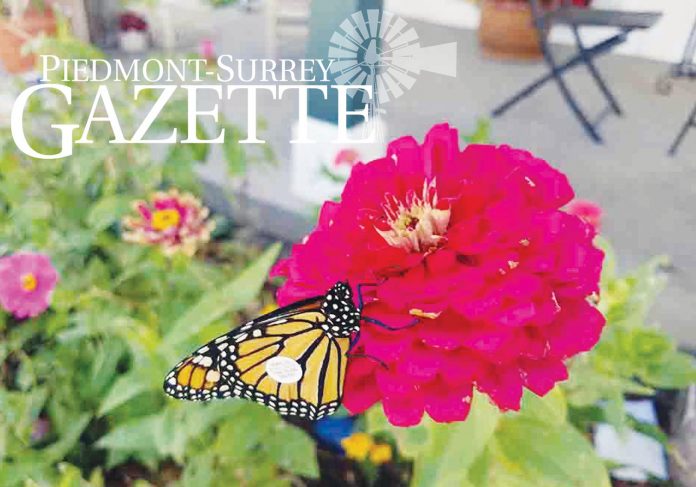
By Carol Mowdy Bond
Contributing Writer
The massive fall migration of monarch Butterflies is in route, and they’ll be passing through Canadian County en masse during the last week of September or the first week of October, on their way to central Mexico.
Do you have the right plants on your property to entice them to stop at your place, and to help them as they fly south?
The main plants they need right now, said Janet Horner, are “nectar plants to feed on as they fly south during their fall migration.
They are right now fattening up for the long winter migrations. Zinnias and daisies and lantana are good nectar plants for monarchs.”
A Canadian County Master Gardener, Horner oversees the 5,000 square feet pollinator gardens at the BlueSTEM AgriLearning Center, located at Ft. Reno, near El Reno. Horner said BlueSTEM has had the pollinator garden for about five years, but this year they are completely redoing the garden, so there’s nothing to see this year.
Three years ago the center became a certified monarch way station. They have to have certain flowers growing at certain times of the year, for Monarchs to forage on and to lay eggs on, to become certified. BlueSTEM is closed to classes and children coming into the building now, due to the pandemic. But normally they have children tagging monarchs this time of year. Horner said, “September and October are the peak months for the monarch migration coming through. Sometimes they go a bit east of El Reno, and sometimes they come right through El Reno. Oklahoma is right in the middle of their 500 mile wide migration path from Canada and northern states and even from Oklahoma, going to Mexico. They start their migration south in August.”
“In Mexico, they’ll winter in oyamel fir tree forests,” Horner said. “Thousands will winter there in a tiny area. In March, they’ll come back through, and lay eggs in Texas and Oklahoma as they go north. In September they go south for their fall migration. In March, they go north for their spring migration, usually at the end of March. These are eastern monarchs because they are east of the Rocky Mountains. There are so many that you can see them on radar as they go to Mexico. Then when they come back north, they’ll lay their eggs and die. Their eggs are the next generation of Monarchs.”

The monarch is the only butterfly that is known to make a two-way migration like birds. Some butterflies can overwinter as larvae, pupae, or adults. But monarchs are unable to survive the cold winters in northern climates. Some will fly as far as 3,000 miles to their winter homes in the trees of Central Mexico. They will winter in those trees in clusters together, in order to stay warm, two miles above sea level. Tens of thousands can stay together in one cluster in a single tree.
“In the 1970s, we began keeping track of monarchs,” Horner said. “We’ve lost 90% of the eastern monarch population. The decline is due to chemicals such as pesticides, and also climate change. But the biggest issue is habitat loss because the only weed they will lay their eggs in is the milk weed. They lay their eggs during their spring migration north. There are several varieties of milk week. Common milk weed takes over. So, farmers plow it up. But people are beginning to realize the problem, and that we need to do something. And now some farmers will leave a strip of milk weed growing.”
“Day of the Dead in Mexico is all about the monarchs,” Horner said. “The people believe that the monarchs are bringing the spirits of their dead family members. So they decorate with mums and Monarchs.”
This year Day of the Dead in Mexico begins on October 31, and ends on November 2. Horner has monarch plants in her yard. She raises monarchs from eggs, bringing the eggs in each day.
“It takes monarchs about 28 days to go from egg to butterfly,” Horner said. She uses her monarchs and eggs to give presentations and lectures to schools, garden clubs, and various groups. To connect with Horner, email her at jchorner12@yahoo.com.





